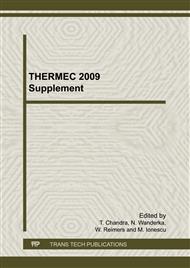[1]
Y. Saito, H. Utsunomiya, N. Tsuji, T. Sakai, Novel ultra-high straining process for bulk materials development of the accumulative Roll-bonding (ARB) process, Acta Materialia, Volume 47, Issue 2, (1999) 579-583.
DOI: 10.1016/s1359-6454(98)00365-6
Google Scholar
[2]
R.Z. Valiev, R.K. Islamgaliev, I.V. Alexandrov, Bulk nanostructured materials from severe plastic deformation, Progress in Materials Science, 45 (2000) 103-189.
DOI: 10.1016/s0079-6425(99)00007-9
Google Scholar
[3]
S.H. Lee, Y. Saito, N. Tsuji, H. Utsunomiya, T. Sakai, Role of shear strain in ultragrain refinement by accumulative roll-bonding (ARB) process, Scripta Materialia 46 (2002) 281- 285.
DOI: 10.1016/s1359-6462(01)01239-8
Google Scholar
[4]
J.A. del Valle, M.T. Pérez-Prado, O.A. Ruano, Accumulative roll bonding of a Mg-based AZ61 alloy, Materials Science and Engineering A 410-411 (2005) 353-357.
DOI: 10.1016/j.msea.2005.08.097
Google Scholar
[5]
M. Karlík, P. Homola, M. Slámová, Accumulative roll-bonding: first experience with a twinroll cast AA8006 alloy, Journal of Alloys and Compounds 378 (2004) 322-325.
DOI: 10.1016/j.jallcom.2003.10.082
Google Scholar
[6]
S. G. Chowdhury, V.C. Srivastava, B. Ravikumar, S. Soren, Evolution of texture during accumulative roll bonding (ARB) and its comparison with normal cold rolled aluminium- manganese alloy, Scripta Materialia 54 (2006) 1691-1696.
DOI: 10.1016/j.scriptamat.2005.12.048
Google Scholar
[7]
G. R. Kingsbury, Friction and Wear of Sliding Bearing Materials. In: ASM Handbook (Friction, Lubrication and Wear technology) Vol. 18, ASM International, (1992).
DOI: 10.1016/0301-679x(93)90010-x
Google Scholar
[8]
R. Schouwenaars, J.A. Torres, V. H. Jacobo and A. Ortiz. Tailoring the Mechanical Properties of Al-Sn-alloys for Tribological Applications. Materials Science Forum, Vols. 539-543 (2007) 317-322.
DOI: 10.4028/www.scientific.net/msf.539-543.317
Google Scholar
[9]
R. Schouwenaars, H. A. Cortéz, V.H. Jacobo, A. Ortiz. Polynomial vs. mechanism-based response surface analysis of the thermomechanical treatment of Al-Sn alloys. Submitted to Materials Science Forum (These proceedings).
DOI: 10.4028/www.scientific.net/msf.638-642.321
Google Scholar
[10]
O. Hernández, G. Gonzalez, Microstructural and mechanical behavior of highly deformed Al- Sn alloys, Mater. Charact. (2007), Article In Press.
Google Scholar
[11]
K. Xu, A.M. Russell, L.S. Chumbley and F.C. Laabs. A deformation processed Al-20% Sn insitu composite. Scripta Materialia 44 (2001) 935-940.
DOI: 10.1016/s1359-6462(00)00679-5
Google Scholar
[12]
K. Xu, A.M. Russell. Texture-strength relationships in a deformation processed Al-Sn metal- metal composite. Materials Science and Engineering, A 373 (2004) 99-106.
DOI: 10.1016/j.msea.2003.12.036
Google Scholar
[13]
J.H. Perepezko, R.J. Hebert y W.S. Tong. Amorphization and nanostructure synthesis in Al alloys. Intermetallics 10 (2002) 1079-1088.
DOI: 10.1016/s0966-9795(02)00144-9
Google Scholar
[14]
R. Schouwenaars, V.H. Jacobo, A. Ortiz. Microstructural aspects of wear in soft tribological alloys. Wear 263 (1-6) (2007), 727-735.
DOI: 10.1016/j.wear.2006.12.037
Google Scholar
[15]
Teodosiu, C. Materials Science Input to Engineering models. Proc. 13. Risoe international symposium on materials science, (1992), 125-146.
Google Scholar
[16]
Rauch, E.F., Gracio, J.J., Barlat, F. Work hardening model for polycrystalline metals under strain reversal at large strains. Acta materialia 55 (2007) 2939-2948.
DOI: 10.1016/j.actamat.2007.01.003
Google Scholar
[17]
Van Houtte, P., Li, S., Seefeldt, M., Delannay, L. Deformation texture prediction: from the Taylor model to the advanced lamel model. International Journal of Plasticity 21 (2005)589643.
DOI: 10.1016/j.ijplas.2004.04.011
Google Scholar
[18]
Wang, Y.M. and Ma, E. Three strategies to achieve uniform tensile deformation in a nanostructured material. Acta Materialia 52 (2004) 1699-1709.
DOI: 10.1016/j.actamat.2003.12.022
Google Scholar


